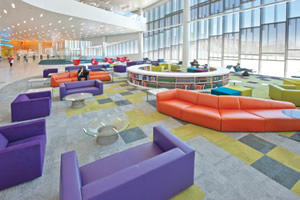Grounding Innovative Learning

NJPA and Milliken helped North Carolina State University give its students durable and colorful flooring in the award-winning James B. Hunt Jr. Library.
As versatile as the needs of a public library are, so must be the interiors. A prime example: The award-winning James B. Hunt Jr. Library — located on North Carolina State’s Centennial Campus in Raleigh.
Snøhetta, an international architecture and interior design office based in Oslo, Norway and New York City, worked closely with Executive Architect Clark Nexsen to specify Milliken floor covering in the library.
The building is mostly composed of large, open spaces that flow from floor-to-floor, and features a variety of brightly colored study and learning environments with dynamic furnishings. Because of the open, flowing concept, being intentional of where and how material and color changes occurred was very important. Carpet, the preferred floor finishing within the majority of the library, was instrumental in tying together the building’s overall look and feel.
“Rich, intense colors were a key factor in the development of the library design, and once we found the Paste Up series we knew it was the right product,” shares Elaine Molinar, the managing director for Snøhetta.
Milliken’s Paste Up collection comes in 50cm tiles with Comfort Plus cushion backing, making them 10 times more efficient in reducing noise compared to other flooring options.
“Our tiles feature built-in antimicrobial protection, exceptional appearance retention ratings and high indoor air quality rating,” notes David Potter, a senior territory manager for Milliken’s global floor covering division.
Reflecting on the project, Molinar is pleased with how North Carolina State’s student body has embraced the space: “The library has been overtaken by students, who are extremely enthusiastic and appreciative of their new ‘home away from home.’ This was our purpose.”
Milliken is a contract-awarded vendor of the National Joint Powers Alliance®. NJPA cooperative purchasing offers choice, value and peace of mind.
www.njpa.co/aboutus
This article originally appeared in the issue of .